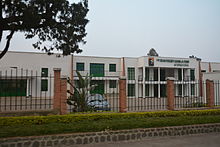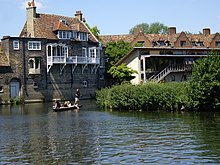Dian Fossey
Dian Fossey (/daɪˈæn/ dy-AN; January 16, 1932 – c. December 26, 1985) was an American primatologist and conservationist known for undertaking an extensive study of mountain gorilla groups from 1966 until her murder in 1985.
[3][4] Fossey spent 20 years in Rwanda, where she supported conservation efforts, strongly opposed poaching and tourism in wildlife habitats, and made more people acknowledge the sapience of gorillas.
However, spending her summer on a ranch in Montana at age 19 rekindled her love of animals, and she enrolled in a pre-veterinary course in biology at the University of California, Davis.
She transferred to San Jose State College[15] where she became a member of Kappa Alpha Theta sorority and studied occupational therapy, receiving her bachelor's degree in 1954.
[22] Fossey turned down an offer to join the Henrys on an African tour due to lack of finances,[7] but in 1963 she borrowed $8,000 (one year's salary), took out her life savings[23] and went on a seven-week visit to Africa.
Their route included visits to Tsavo, East Africa's largest national park; the saline lake of Manyara, famous for attracting giant flocks of flamingos; and the Ngorongoro Crater, well known for its abundant wildlife.
Baumgartel, an advocate of gorilla conservation, was among the first to see the benefits that tourism could bring to the area, and he introduced Fossey to Kenyan wildlife photographers Joan and Alan Root.
Three years after the original safari, Leakey suggested that Fossey could undertake a long-term study of the gorillas in the same manner as Jane Goodall had with chimpanzees in Tanzania.
[18] Accompanied by photographer Alan Root, who helped her obtain work permits for the Virunga Mountains, Fossey began her field study at Kabara, in the Congo in early 1967, in the same meadow where Schaller had made his camp seven years earlier.
Living in tents on mainly tinned produce, once a month Fossey would hike down the mountain to "Lily" and make the two-hour drive to the village of Kikumba to restock.
[18][26] Advised by the Ugandan authorities not to return to Congo, after meeting Leakey in Nairobi, Fossey agreed with him against US Embassy advice to restart her study on the Rwandan side of the Virungas.
[18] On September 24, 1967, Fossey founded the Karisoke Research Center, a remote rainforest camp nestled in Ruhengeri province in the saddle of two volcanoes.
Her bestselling book Gorillas in the Mist was praised by Nikolaas Tinbergen, the Dutch ethologist and ornithologist who won the 1973 Nobel Prize in Physiology or Medicine.
[8] Many research students left after not being able to cope with the cold, dark, and extremely muddy conditions around Karisoke on the slopes of the Virunga Volcanoes, where paths usually had to be cut through six-foot-tall grass with a machete.
Later that year, the silverback of Digit's Group 4, named for Fossey's Uncle Bert, was shot in the heart while trying to save his son, Kweli, from being seized by poachers cooperating with the Rwandan park conservator.
[39] Fossey mostly opposed the efforts of the international organizations, which she felt inefficiently directed their funds towards more equipment for Rwandan park officials, some of whom were alleged to have ordered some of the gorilla poachings in the first place.
[43] In a letter to a friend, she wrote, "We stripped him and spread eagled him and lashed the holy blue sweat out of him with nettle stalks and leaves..."[31] She even reportedly kidnapped and held for ransom the child of a suspected poacher.
[31] Writing in The Wall Street Journal in 2002, the journalist Tunku Varadarajan described Fossey at the end of her life as colorful, controversial, and "a racist alcoholic who regarded her gorillas as better than the African people who lived around them".
[31] However, robbery was evidently not the motive for the crime, as Fossey's valuables were still in the cabin, including her passport, handguns, and thousands of dollars in U.S. bills and traveler's checks.
[47][48] The last entry in her diary read:[49][1] When you realize the value of all life, you dwell less on what is past and concentrate more on the preservation of the future.Fossey is buried at Karisoke,[50][51] in a site that she herself had constructed for her deceased gorilla friends.
This included Rwandan Emmanuel Rwelekana, a tracker who had been fired from his job after he allegedly tried to kill Fossey with a machete, according to the government's account of McGuire's trial.
[54] Following his return to the U.S., McGuire gave a brief statement at a news conference in Century City, Los Angeles, saying Fossey had been his "friend and mentor", calling her death "tragic" and the charges "outrageous".
[55] Thereafter, McGuire was largely absent from public notice until 2005, when news broke that he had been accepted for a job with the Health and Human Services division of the State of Nebraska.
[4] Since Fossey would rescue any abused or abandoned animal she saw in Africa or near Karisoke, she acquired a menagerie in the camp, including a monkey who lived in her cabin, Kima, and a dog, Cindy.
[59] Fossey had been troubled by lung problems from an early age and, later in her life, developed advanced emphysema brought on by years of heavy cigarette smoking.
[60][61] As the debilitating disease progressed—further aggravated by the high mountain elevation and damp climate—Fossey found it increasingly difficult to conduct field research, frequently experiencing shortness of breath and requiring the help of an oxygen tank when climbing or hiking long distances.
[8] Fossey also criticized tourist programs, often paid for by international conservation organizations, for interfering with both her research and the peace of the mountain gorillas' habitat, and was concerned that Jane Goodall was inappropriately changing her study of chimpanzees' behavior.
Portions of the story and the Hayes article were adapted for the film Gorillas in the Mist, starring Sigourney Weaver, who played Fossey, along with Bryan Brown, and John Omirah Miluwi.
The book covers Fossey's scientific career in great detail and omits material on her personal life, such as her affair with photographer Bob Campbell, played by Bryan Brown.
Fowler represents Fossey as a chain-smoking, hard-drinking woman who bullied her staff and students in her efforts to hold on to her reputation as scientist and savior of the mountain gorillas.




